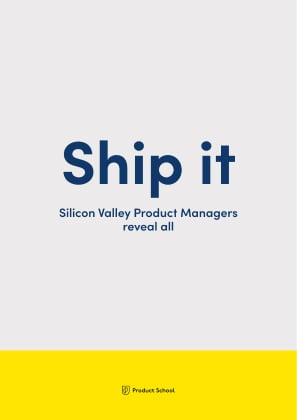Updated: November 29, 2024- 11 min read
Ecommerce sales are estimated to pass the $4 trillion dollar mark this year. Just think, if you took $4 trillion dollars out of the bank in $100-dollar bills and laid them end to end, they would wrap around the earth’s equator 156 times. All those times we clicked “add to cart” have really added up!
Eccommerce is a huge industry, and that’s an understatement. The good news is that all these ecommerce companies need Product Managers. Someone has to make sure that those “add to cart” buttons are working correctly.
Okay, but besides checking up on buttons, what does an ecommerce Product Manager actually do? How are they different from other types of PMs? We’ll be getting into all that in the article below, along with the skills, salaries, and daily tasks of PMs who work in ecommerce.

What Is an E-Commerce Product Manager?
I think that shipping is a drug we’re all addicted to.
— Daniel Danker, Chief Product Officer at Instacart on The Product Podcast, The Secrets of Instacart's AI
Ecommerce product managers work primarily with online retail platforms. They are responsible for defining the strategy, managing the roadmap, and overseeing the development of digital products to enhance the user experience and drive business growth. In essence, an ecommerce PM ensures that customers can seamlessly browse, buy, and interact with a brand’s online store while meeting company revenue and efficiency goals.
Ecommerce PM Job Descriptions
1. Amazon:
Amazon’s ecommerce product managers often work on improving search algorithms, optimizing product recommendations, and streamlining the checkout process. A typical role at Amazon might involve managing features that reduce cart abandonment rates or tools to personalize the shopping experience for millions of users.
2. Instacart:
Instacart's Product Managers focus on enhancing the grocery shopping experience through their digital platform. This includes developing features that enable customers to discover new products, building tools for retail partners to grow their online grocery businesses, and creating workflows that help personal shoppers earn via the platform.
3. Nike:
Nike’s ecommerce product managers oversee their digital storefront, ensuring a smooth and engaging experience for shoppers. This includes everything from optimizing product pages to managing integrations with inventory and logistics systems.
A great to understand what ecommerce PMs really do day-to-day is to look at job postings for the role, of which there are many. Here’s an example from Columbia Sportswear:

4. Columbia: At Columbia Sportswear, ecommerce Product Managers lead the development of innovative, data-driven solutions to enhance customer experiences and align with strategic business goals. They craft product visions and roadmaps for checkout and payment systems, leveraging insights from user workshops, market trends, and stakeholder discussions. Responsibilities include prioritizing features, managing trade-offs, and driving omni-channel transformations while ensuring timely, on-budget project delivery.
Ecommerce PM salaries
Compensation for ecommerce Product Managers varies based on experience, location, and company size. In the US, the average salary ranges somewhere between $140,000 and $160,000 per year. In addition to base salaries, many companies offer equity, bonuses, and comprehensive benefits packages that can significantly increase total compensation.
8 Skills Ecommerce Product Managers Need to Master
The reason why Amazon produces successful products over and over again is because every product manager is challenged to start with the customer first.
— fmr Amazon Product Executive, Bhushan Shinkre in the webinar Product Vision & Strategy hosted by Product School
1. Product vision and strategy
Ecommerce product managers must excel at defining a clear product vision and aligning it with overarching business goals. This includes setting long-term objectives, prioritizing initiatives that drive growth, and communicating the strategy to stakeholders across the organization.
2. Roadmapping and prioritization
Creating and managing effective roadmaps is essential for balancing short-term wins with long-term goals. Ecommerce PMs use product roadmaps to manage workflows and prioritize features based on customer impact, business value, and technical feasibility.
3. Data analysis
Strong analytical skills are key to understanding user behavior and identifying opportunities for optimization. Ecommerce product managers must interpret data on shoppers’ behavior and purchasing patterns to make informed bets on how to improve conversions and revenue.
4. Mastery of product management frameworks
Ecommerce PMs must be fluent in a variety of product management frameworks such as Agile methodology or Jobs To Be Done (JBTD) to adapt their approach to different project needs. These frameworks guide the development process, from ideation to launch, ensuring efficient and effective delivery.
5. User research
A deep understanding of customer needs is vital. Ecommerce PMs gather insights through user interviews, surveys, competitive analysis, and data analysis to create solutions that resonate with their audience and stay ahead of industry shifts.
6. Collaboration and stakeholder management
Ecommerce PMs often work cross-functionally, collaborating with engineering, marketing, UX, and other teams. Strong communication and negotiation skills are necessary to align diverse stakeholders around a shared vision and ensure smooth project execution.
7. Pricing strategies
Optimizing pricing strategies is crucial for driving revenue. This includes understanding competitor pricing, conducting A/B testing, and implementing techniques like dynamic pricing, bundling, and discounting to maximize customer value and profitability.
8. Facility with ecommerce management platforms and tools
While not required to code, ecommerce PMs need a solid grasp of the technical aspects of product development. Familiarity with APIs, databases, and ecommerce platforms, such as:
Shopify
Salesforce Commerce Cloud
Magento
Ecommerce Product Manager Responsibilities
Ecommerce product managers are at the heart of building and refining digital shopping experiences. They take ownership of the product roadmap, collaborate across teams, and ensure features align with both customer needs and business goals. Below are the key areas of responsibility for an ecommerce PM:
Developing and managing the product roadmap: Define and maintain a strategic roadmap that aligns with business objectives and prioritizes the most impactful features.
Optimizing the user experience: Improve site functionality and design to enhance engagement and drive conversions.
Collaborating across departments: Work with marketing, sales, and customer service teams to align product goals and ensure seamless execution.
Conducting A/B testing: Experiment with new features, analyze results, and iteratively improve the product.
Monitoring performance metrics: Track KPIs like conversion rates, bounce rates, and customer retention, adjusting strategies as necessary.
Managing integrations: Oversee integrations with payment gateways, shipping providers, and inventory systems to maintain a seamless customer experience.
Staying up-to-date: Keep up with industry trends, competitor advancements, and evolving customer expectations to inform future product updates.
A day in the life of an ecommerce product manager
9:00 AM - Team stand-up
Start the day with a quick team stand-up to align on priorities, discuss progress, and address any blockers. This is the time to ensure everyone is clear on their tasks and understands the goals for the day.
11:30 AM - Analyzing metrics and performance
Dive into data to evaluate product performance. Whether it’s reviewing conversion rates, cart abandonment data, or customer feedback, this analysis informs decisions for upcoming initiatives or experiments.
1:00 PM - Stakeholder meeting
Meet with cross-functional teams such as marketing, UX, and engineering to discuss product roadmaps, gather input, and ensure alignment across departments. This is also a good time to address dependencies or adjust priorities based on business needs.
3:00 PM - Refining the backlog
Focus on refining the product backlog by prioritizing user stories, updating acceptance criteria, and ensuring all tasks are well-defined and ready for the next sprint. Collaborate with developers to clarify requirements if needed.
4:30 PM - Planning and strategy
Wrap up the day by reviewing the long-term product vision and strategy. Use this time to outline high-level roadmaps, assess progress toward quarterly goals, or research industry trends that could impact future plans.
Unique Challenges of Ecommerce Product Management
What really sets retail product managers apart from their counterparts in SaaS, healthcare, banking, or any other industry, is the challenges they face in a highly competitive marketplace where consumers are spoiled for choice.
1. Inspiring customer loyalty
Whilst we won’t go as far as to say that other products have it easy, it is easier to encourage brand loyalty when your product requires more commitment from the user.
For example, once Apple sells an iPhone to someone, they’ll be using that iPhone for a long time. The idea of changing to a different brand of phone feels like a lot of effort. The same can be said for SaaS products, often people get accustomed to working in a certain way and don’t like to feel disrupted.
However, if you have an online shoe store, for example, it’s entirely likely that your customer will come, buy one pair of shoes, and then never come back.
All you’ve gained from that customer is the revenue on a single pair of shoes and maybe some word-of-mouth value.
Let’s face it, we don’t need most of the things we buy online. So what about the product experience in an online shopping interaction—selecting the item, purchasing it, and having it delivered—can convince the customer to buy something instead of abandoning cart?
This is where an ecommerce PM’s user research skills come into play. Product growth strategies like growth loops are also essential to keep customers coming back.
When we know that a customer is going to keep coming back, then we're able to unlock a lot more value for them.
— Daniel Danker, Chief Product Officer at Instacart on The Product Podcast, The Secrets of Instacart's AI
2. Crowded markets
There are simply far too many ecommerce businesses. No matter what we want to buy, we can find it online and have it shipped to us within a reasonable amount of time.
Not only that, a few behemoths monopolize the market. Coupled with the advantage of being household names, with free shipping and loyalty schemes, the competition is pretty fierce. This is why ecommerce PMs need to have product pricing and market fit down pat.
3. Scalability
You thought you needed to be organized when you were in charge of just one product! Depending on the size of their offerings, online businesses have to look after hundreds…thousands…even hundreds of thousands!
As a retail PM, it’s your job to ensure that everything runs smoothly behind the scenes, which means no files, SKUs, or images go missing. This is where your trusty product management frameworks like Kanban and Scrum become necessary to keep track of everything that needs doing.
How is this different from normal Product Management? Well, it is, and it isn’t.
All Product Managers need to be highly organized, but in ecommerce you need to be aware of special tools that specifically cater to that kind of business like Shopify, Salesforce Commerce Cloud, and Magento.
For example, you’ll need to pick SaaS for inventory management, automating orders to manufacturers, etc.
4. Instilling trust in your product
But in ecommerce you also need your product to be trustworthy, especially if you’re not yet working with a household brand name.
Unfortunately, the zeitgeist is full of tales of ordering a new bed and realizing it’s for a dollhouse. As they’re sitting at the checkout with their credit card in hand, your customers have a lot of what-ifs in mind…
What if it never arrives?
What if I hate it and have to pay to return it?
What if it’s a scam, and this $20 smartwatch is actually made of rubber?
What if this whole website is fake, and they’re just stealing my data?
You need to make sure every step of the user journey reassures them. Something as small as weird button positioning can make them think twice.
When the Real Product Is the Website...
…product management skills are in high demand. When ecommerce is the sole or central way that a company makes money, the retail experience via the website has to be superb. Nothing less will do. Hence why ecommerce product management is such a challenging yet rewarding role.
In an industry that’s growing at breakneck speed, ecommerce PMs have the opportunity to shape how people shop online—ensuring that the journey from “add to cart” to “thank you for your purchase” is as smooth as possible. Combining skills like data analysis, user research, and strategic vision, they help companies stay competitive in a crowded marketplace, keep customers coming back, and, ultimately, drive the business forward. Whether you’re just starting out in product management or looking to move into the ecommerce space, the future here is promising—and definitely worth exploring.
Enroll in Product School's Product Strategy Micro-Certification (PSC)™️
The difference between a good and a great product lies in your Product Strategy, answering vital questions like: Who's the product for? What benefits does it offer? How does it further company objectives?
Enroll for Free
Updated: November 29, 2024





